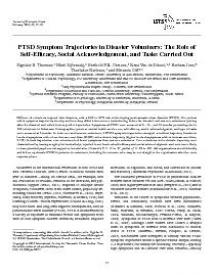PTSD symptom trajectories in disaster volunteers : The role of self-efficacy, social acknowledgement, and tasks carried out
Millions of volunteers respond after disasters, with a 24% to 46% risk of developing posttraumatic stress disorder (PTSD). It is unclear which symptom trajectories develop and how they differ between core (volunteering before the disaster) and noncore volunteers (joining after the disaster) and which factors predict trajectories. Symptoms of PTSD were assessed at 6-, 12-, and 18-months postearthquake in 449 volunteers in Indonesia.
Demographics, previous mental health service use, self-efficacy, social acknowledgment, and type of tasks were assessed at 6 months. In both core and noncore volunteers, 2 PTSD symptom trajectories emerged: a resilient trajectory (moderate levels of symptoms with a slow decrease over time; 90.9%) and a chronic trajectory (higher levels of symptoms with an increase over time; 9.1%). In both trajectories, core volunteers had fewer symptoms than noncore volunteers.
Core volunteers in the chronic trajectory were characterized by having sought prior mental help, reported lower levels of self-efficacy and social acknowledgment, and were more likely to have provided psychosocial support to beneficiaries (Cramér's V = .17 to .27, partial η(2) = .02 to .06). Aid organizations should identify and follow up chronic PTSD trajectories in volunteers, including the noncore, who may be out of sight to the organization after the acute response phase.
Geachte bezoeker,
De informatie die u nu opvraagt, kan door psychotraumanet niet aan u worden getoond. Dit kan verschillende redenen hebben,
waarvan (bescherming van het) auteursrecht de meeste voorkomende is. Wanneer het mogelijk is om u door te verwijzen naar de bron
van deze informatie, dan ziet u hier onder een link naar die plek.
Als er geen link staat, kunt u contact opnemen met de bibliotheek,
die u verder op weg kan helpen.
Met vriendelijke groet,
Het psychotraumanet-team.
In: Journal of traumatic stress, ISSN 0894-9867 | 29 | 1 | 17-25
http://doi.org/10.1002/jts.22073


